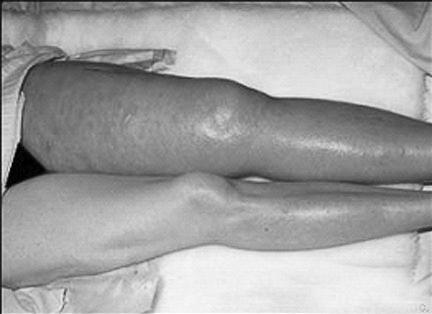By Dr Suhel Kotwal, MS
Deep vein thrombosis, or DVT, is a blood clot that forms in a vein deep in the body. Blood clots occur when blood thickens and clumps together. Most deep vein blood clots occur in the lower leg or thigh. A blood clot in a deep vein can break off and travel through the bloodstream. The loose clot is called an embolus. When the clot travels to the lungs and blocks blood flow, the condition is called pulmonary embolism (PE). This is a very serious condition which can cause death.
Blood clots in the thigh are more likely to break off and cause PE than blood clots in the lower leg or other parts of the body.
What causes DVT?
Blood clots can form in your body’s deep veins when:
* Damage occurs to a vein’s inner lining from injuries caused by physical, chemical, and biological factors such as surgery, serious injury or inflammation.
* Slow blood flow encouraging clotting. This may occur after surgery, if you’re ill and in bed or if you’re travelling.
* Your blood is thicker or more likely to clot than usual, like in people on hormone replacement therapy or birth control pills.
Who is at risk for DVT?
Many factors increase your risk for DVT. They include:
* A history of DVT.
* Use of hormone replacement therapy or birth control pills.
* Injury to a deep vein from surgery, a broken bone, or other trauma.
* Slow blood flow in a deep vein from lack of movement, like in bedridden patients
* Pregnancy and the first 6 weeks after giving birth.
* Ongoing treatment for cancer.
* Being older than 60.
* Being overweight or obese.
What are the signs and symptoms of DVT?
The signs and symptoms of DVT may be related to DVT itself or to PE. Both can possibly cause life-threatening complications if not treated.
DVT
Only about half of the people with DVT have symptoms. They include:
* Swelling of the leg or a vein along the leg
* Pain in the leg, which you may feel only when standing or walking
* Increased warmth in the area of the leg
* Red or discolored skin on the leg
PE
Some people don’t know they have DVT until they have signs or symptoms of PE. They include:
* Unexplained shortness of breath
* Pain with deep breathing
* Coughing up blood
How is DVT diagnosed?
Your doctor will diagnose DVT based on your medical history, a physical exam, and the results from tests. He or she will identify your risk factors and rule out other causes for your symptoms.
Medical history
* To learn about your medical history, your doctor may ask about your health, prescription drugs, surgeries and cancers.
Physical exam

1. Ultrasound: This is the most common test for diagnosing deep vein blood clots.
2. A D-dimer test: This test measures a substance in the blood that is released when a blood clot dissolves. If the test shows high levels of the substance, you may have a deep vein blood clot.
3. Venography: Dye is injected into a vein, and then an x-ray is taken of the leg. The dye makes the vein visible on the x ray.
Other less common tests used to diagnose DVT include magnetic resonance imaging (MRI) and computed tomography (CT) scanning.
4. Blood clotting tests
How is deep vein thrombosis treated?
Goals of treatment
a. The main goals of treating deep vein thrombosis (DVT) are to:
b. Stop the blood clot from getting bigger
c. Prevent the blood clot from breaking off and moving to your lungs
d. Reduce your chance of having another blood clot
Medicines
Medicines are used to prevent and treat DVT.
Anticoagulants are the most common medicines for treating DVT. They’re known as blood thinners. They also stop existing blood clots from getting bigger.
Blood thinners can be taken as either a pill, an injection under the skin, or through a needle inserted into a vein.
Warfarin and heparin are two blood thinners used to treat DVT. Heparin acts quickly. Warfarin (not used during pregnancy) takes 2 to 3 days before it starts working. Treatment for DVT with blood thinners usually lasts from 3 to 6 months.
The most common side effect of blood thinners is bleeding. This happens if the medicine thins your blood too much. This side effect can be life threatening.
Call your doctor right away if you have easy bruising or bleeding. This may be a sign that your medicines have thinned your blood too much.
Other types of treatment
Vena cava filter
A vena cava filter is used if you can’t take blood thinners or if you’re taking blood thinners and still developing blood clots.
The filter is inserted into a large vein called the vena cava. The filter catches blood clots that break off in a vein before they move to the lungs. However, it doesn’t stop new blood clots from forming.
Compression stockings

These stockings are tight at the ankle and become looser as they go up the leg. This creates gentle pressure up the leg which keeps blood from pooling and clotting.
These stockings should be worn for at least a year after DVT is diagnosed.
How can deep vein thrombosis
be prevented?
* Seeing your doctor for regular checkups.
* Taking all medicines your doctor prescribes.
* Getting out of bed and moving around as soon as
possible after surgery or illness.
* Exercising your lower leg muscles during long trips.
Travel Tips
Your risk of developing DVT while travelling is small. The risk increases if the travel time is longer than four hours, or if you have other risk factors for DVT.
During long trips, it may help to:
* Walk up and down the aisles of the bus, train, or airplane. If travelling by car, stop about every hour and walk around.
* Move your legs and flex and stretch your feet to encourage blood flow in your calves.
* Wear loose and comfortable clothing.
* Drink plenty of fluids and avoid alcohol.
If you’re at increased risk for DVT, your doctor may recommend wearing compression stockings during travel or taking a blood-thinning medicine before travelling.





